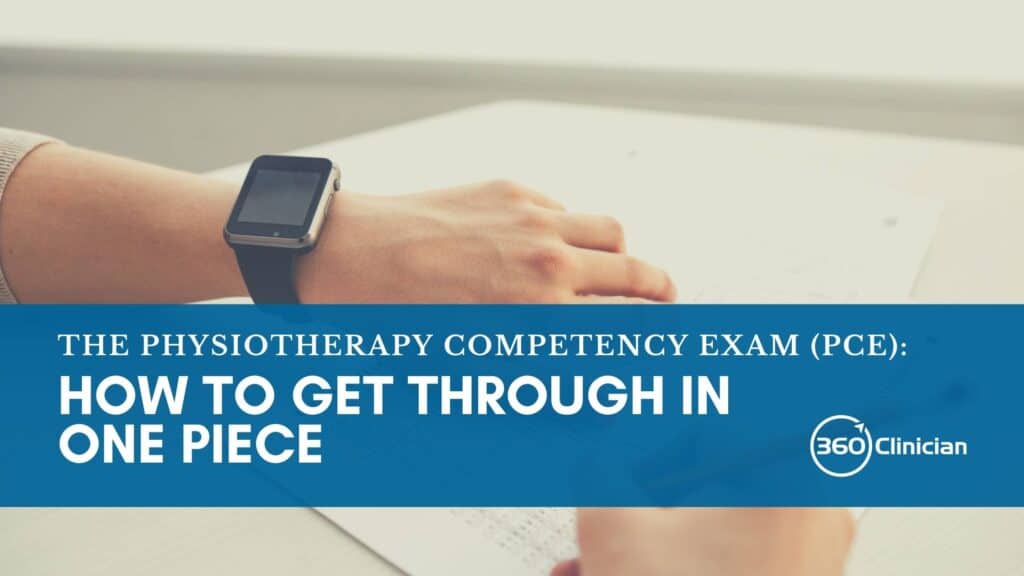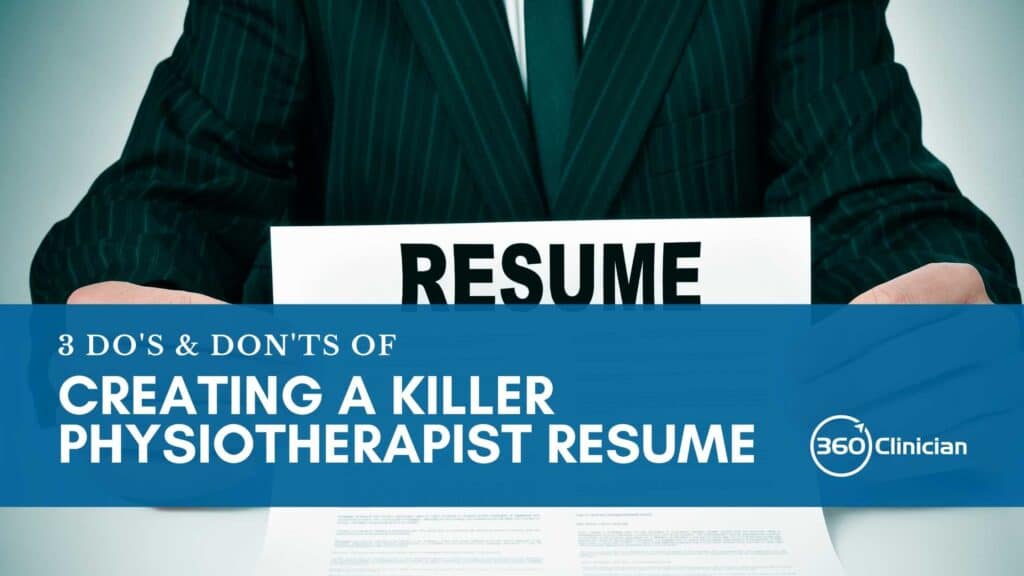You’ve memorized your theory, wrapped up your course work, passed every test and completed your practicum requirements.
So now it’s time to be a real physiotherapist, right?! Not quite yet. Before you are able to put all of that hard work to use, there’s one more hurdle to overcome: The Physiotherapy Competency Exam (PCE). Getting ready to take on the PCE can feel like an impossible task, but worry not!
In this article, I give you a quick rundown of the PCE and effective test-taking tips for multiple choice and practical exams so that you can nail the PCE on test day.
What is the PCE?
The PCE is a two-part nationwide Canadian exam designed to test a candidate’s competency and safety in working as a physiotherapist.
The first part of the PCE is the written component. According to the Canadian Alliance of Physiotherapy Regulators, the PCE is a 4 hour exam with 200 multiple choice questions administered online. The written component is designed to assess an individual’s understanding of interviewing and communication, history-taking, physical examination, data interpretation, clinical problem solving and treatment skills, ethics and safety. Clinical practice fields covered include neuro-musculoskeletal, neurological, cardiopulmonary-vascular and multi systems in patient populations ranging from pediatrics to geriatric groups.
After passing the written portion, the PCE clinical component is next. This exam is designed to evaluate your ability to take the knowledge that you have reviewed in preparation for the written component and apply it safely and competently in practice. You will have 5-6 hours to complete 16 exam stations. Eight stations will be 10 minute long interactions with a standardized patient. The remaining 8 stations will be a combination of 5 minute interactions with standardized patients and 5 minute written questions.
For more information about the PCE and for registration visit http://www.alliancept.org.
Multiple Choice Questions
Multiple choice questions are all the same. A question is followed by 4 or 5 possible answers and your job is to select the best answer. Lucky for you, because of this repetitive structure, multiple choice questions can all be tackled in the same way. This means that no matter the question difficulty you’ll know where to start in choosing the best answer.
- First, begin by reading the question carefully, and familiarize yourself with it to determine what the question is asking you to do.
- Next, read the question again and highlight the words most relevant to the question.
- Before scanning the list of possible answers, try to come up with an answer to the question in your head.
- Once this is done, review all the possible answer options.
- Eliminate the options you know are not right. This allows you to use the process of elimination to narrow down your choices.
- Finally, choose the option that best answers the question.
PCE Written Component Tips
Everyone has encountered their fair share of exams throughout their undergraduate and graduate careers. Here are the top 10 tips that have served me well over the years and which I believe will help you achieve success with the PCE written component.
- Re-create your study environment. If you studied with ear plugs, make sure you have some for test day.
- Start with a quick review. Before you start answering questions, familiarize yourself with the layout of the exam and make sure that you have all the pages.
- Answer every question. There is no penalty for guessing in the PCE!
- Answer the questions you feel confident about first. Mark the questions that you are less confident about and come back to them later.
- Trust your instincts! (it’s okay to change your answer only if you feel strongly that another option is the correct one)
- Budget your time. Plan your time accordingly and pace yourself.
- Take mini-breaks. If you are struggling throughout the test, close your eyes for a moment, take a few deep breaths to allow yourself to re-focus and continue on. Caution! Be mindful of your time when taking a break.
- Fill in your answer sheet as you go. Ensure you are filling in the correct line if you have skipped previous questions.
- Don’t play the odds. If guessing, the question is not always “C” and if the last 3 options have been “D”, it doesn’t mean that the next option can’t be as well.
- Do a final review. If time allows, review all questions and answers before you submit your test.
Clinical Exam Scenarios
Once you have successfully passed the PCE written component, it’s time to start thinking about the clinical portion. For many students the thought of completing a practical exam is intimidating. We may have much more past experience with multiple choice or written questions and are unsure of how to best prepare for a practical format. Clinical exams are unique because they examine your ability to think on your feet, communicate and interact with others as well as your ability to master technical assessment or treatment techniques. And as you continue on with your physiotherapy career past the PCE, clinical exams will continue to be a requirement to gain post-graduate certifications and courses.
Like all other exams, however, feeling prepared is the first step towards success. Similar to multiple choice questions, developing a framework from which you can tackle any clinical exam scenario is a great way to boost your confidence and organize your thoughts for exam day. Follow this 10 step framework with any clinical scenario:
- First read the station thoroughly.
- Highlight the important components and what they are asking you to do on the notebook you will be given on exam day.
- Enter the room and quickly scan the room for its setup and equipment available to you.
- Introduce yourself.
- Explain what you are going to do to the standardized patient.
- Gain informed consent from the patient.
- Demonstrate the task first.
- Ask the patient if they have any questions.
- Supervise the patient.
- Provide feedback to the standardized patient.
PCE Clinical Component Tips
Just like with written exams, I’ve brainstormed a list of 15 clinical exam prep and test day tips that can help you succeed.
- Have a study partner. Practice with someone who is also preparing for the exam. If you do not already have a study partner, Facebook groups for Canadian physiotherapy programmes or Internationally Educated Physiotherapist (IEPT) groups may allow you to connect with others more readily.
- Practice both roles. When practicing with your partner, alternate who is the standardized patient and who is the physiotherapist. This way you will both have an opportunity to practice and provide feedback to the other.
- Don’t worry about consent. In exam scenarios specific to the PCE, assume you have already gained patient consent unless otherwise specified. In most other clinical exams, you will have to demonstrate your ability to gain a patient’s informed consent first thing.
- Safety! Maintaining patient safety should be your #1 priority.
- Body mechanics matter. Remember to display proper body mechanics when demonstrating or providing a treatment with a standardized patient.
- Skip the medical jargon. Use layman’s or common language when interacting with the standardized patient. Imagine that they have no idea what physiotherapy is.
- Speak only to the standardized patient. Imagine there isn’t anyone else in the room.
- Anticipate your setup. Scan the room for available equipment before you start. Make sure that everything you may need during the scenario is close enough that you can access it without putting the patient’s safety in jeopardy.
- Don’t expect any help from the examiners. Imagine that it’s only you and the patient in the room.
- Review the scenario if needed. In most instances a copy of the exam scenario will be available in the room. Don’t hesitate to reference it if you need to.
- Think out loud. In situations where you may be asked to observe or critique a patient’s gait, posture, etc. make sure you express your thought process out loud. The examiner isn’t a mind reader and you will not do well if they are unable to hear what you are thinking.
- Eat the snacks provided. The PCE is a long exam. It will be divided into 2 parts with a short break allotted half way. Eat to keep your energy levels up.
- Don’t get fancy. Follow the scenario and do only what it asks you to do. You won’t get any additional marks for going above and beyond.
- Let it go! There will likely be a few stations that you don’t feel so great about. It’s important that you leave it behind you. Carrying forward worries or frustrations from past stations will negatively affect your future stations.

